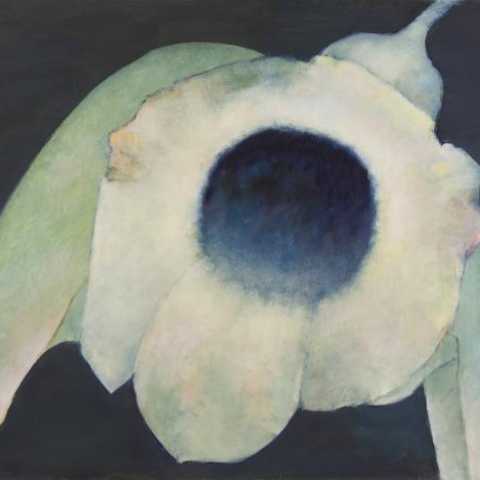
2 September - 1 October 2016
Private View: Thursday 1 September, 6 - 8 pm
Alison Jacques Gallery is delighted to exhibit Dorothea Tanning's final paintings, which will be, shown together for the first time since 1999. Conceived as a series of 12, these imaginary blooms were painted in 1997-98 and published together with poems written by contemporary poets in an anthology the artist called Another Language of Flowers (1998). Nearly 20 years since they were made, Alison Jacques Gallery will exhibit the six flower paintings that remained in Tanning's collection at the time of her death in 2012.
In the months before beginning this series, at the age of 86, the artist thought she had finished painting in her New York studio but then remembered a set of stretched Lefebvre-Foinet canvases, which she had purchased years earlier while living in Paris, and was compelled to use one. Her discovery provoked 'a burst of energy and obsession that lasted the better part of eight months and was responsible for 12 outsized, hauntingly erotic flower paintings†(Jane Kramer, The New Yorker, 2004). 'I had a vision of a mauve flower,†Tanning says of that time, 'Then more and more wanted to be painted. I could hardly finish one before I'd start the next one†(Boston Globe, 1999). Using preliminary sketches as 'touchstones on the way to the flowers,†the artist represented 'naked, precise depictions of visions as real to me as botanical specimens are to the scientist†(Another Language of Flowers, 1998).
Tanning painted 12 flowers over the course of a year, from June 1997 until April 1998; one for each month of the year, or one for each hour of the day or night. Her preoccupation with the female figure, which is evident throughout her work from the 1940s onwards, remains present in these last paintings, where bodies and limbs embrace the flowers or blend into her dream-like landscapes. Tanning's hybrid flowers take us on a journey through a never-before-seen garden, which she described as a 'foray into imaginary botanyâ€. As she wrote, each flower 'had the good fortune to be identified and blessed with the words of twelve poets, friends of the artist, who have given them their voices†(Another Language of Flowers, 1998). With the exception of James Merrill, who is quoted posthumously, the poets were inspired by the images themselves to write poems and create fictitious Latin names, sometimes with a faux-translation in English: Agripedium vorax Saccherii (Clog Herb); Siderium exaltatum (Starry Venusweed); Zephirium apochripholiae (Windwort); Pictor mysteriosa (Burnt Umbrage); Victrola floribunda; and Convolotus alchemilia (Quiet-willow window).
Dorothea Tanning was born in Galesburg, Illinois (1910) and died in New York (2012), aged 101. She lived in Chicago, New York, Arizona, and for nearly 30 years in France with her husband Max Ernst, returning to New York after his death. Her diverse oeuvre encompasses painting, sculpture, printmaking, and designs for ballet and theatre, as well as poetry. Although she is often linked with the Surrealist movement, it is evident that her career, which spanned over six decades, evolved and developed its own unique vocabulary. Her works have been acquired by major institutions including Tate, London; Centre Georges Pompidou, Paris; Philadelphia Museum of Art; Museum of Modern Art, New York; San Francisco Museum of Modern Art; Museum of Contemporary Art, Chicago; the Whitney Museum of American Art, New York; the Menil Collection, Houston; and Moderna Museet, Stockholm.
Key solo shows in Tanning's lifetime include Centre Georges Pompidou, Paris (1974); Camden Arts Centre, London (1993); Malmö Konsthall, Malmö (1993); and Philadelphia Museum of Art (2000). Organised in collaboration with The Destina Foundation, New York, the show at Alison Jacques Gallery will overlap with Making and Unmaking: An Exhibition Curated by Duro Olowu, Camden Arts Centre, London (19 June - 18 September 2016), which features two works by Tanning.
